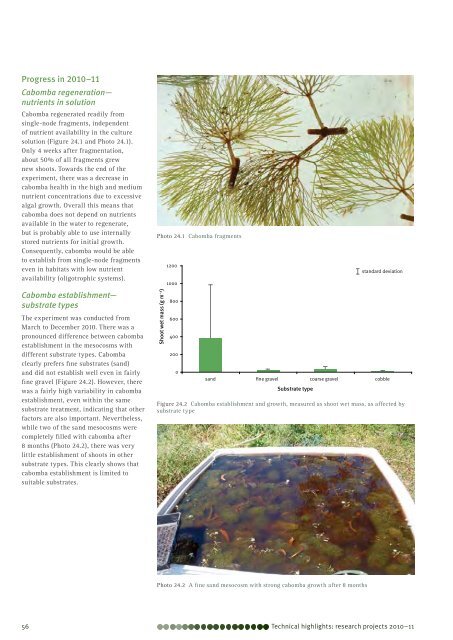Technical highlights - Department of Primary Industries ...
Technical highlights - Department of Primary Industries ...
Technical highlights - Department of Primary Industries ...
Create successful ePaper yourself
Turn your PDF publications into a flip-book with our unique Google optimized e-Paper software.
Progress in 2010–11<br />
Cabomba regeneration—<br />
nutrients in solution<br />
Cabomba regenerated readily from<br />
single-node fragments, independent<br />
<strong>of</strong> nutrient availability in the culture<br />
solution (Figure 24.1 and Photo 24.1).<br />
Only 4 weeks after fragmentation,<br />
about 50% <strong>of</strong> all fragments grew<br />
new shoots. Towards the end <strong>of</strong> the<br />
experiment, there was a decrease in<br />
cabomba health in the high and medium<br />
nutrient concentrations due to excessive<br />
algal growth. Overall this means that<br />
cabomba does not depend on nutrients<br />
available in the water to regenerate,<br />
but is probably able to use internally<br />
stored nutrients for initial growth.<br />
Consequently, cabomba would be able<br />
to establish from single-node fragments<br />
even in habitats with low nutrient<br />
availability (oligotrophic systems).<br />
Cabomba establishment—<br />
substrate types<br />
The experiment was conducted from<br />
March to December 2010. There was a<br />
pronounced difference between cabomba<br />
establishment in the mesocosms with<br />
different substrate types. Cabomba<br />
clearly prefers fine substrates (sand)<br />
and did not establish well even in fairly<br />
fine gravel (Figure 24.2). However, there<br />
was a fairly high variability in cabomba<br />
establishment, even within the same<br />
substrate treatment, indicating that other<br />
factors are also important. Nevertheless,<br />
while two <strong>of</strong> the sand mesocosms were<br />
completely filled with cabomba after<br />
8 months (Photo 24.2), there was very<br />
little establishment <strong>of</strong> shoots in other<br />
substrate types. This clearly shows that<br />
cabomba establishment is limited to<br />
suitable substrates.<br />
Photo 24.1 Cabomba fragments<br />
Shoot wet mass (g m –2 )<br />
1200<br />
1000<br />
800<br />
600<br />
400<br />
200<br />
0<br />
sand fine gravel coarse gravel cobble<br />
Substrate type<br />
standard deviation<br />
Figure 24.2 Cabomba establishment and growth, measured as shoot wet mass, as affected by<br />
substrate type<br />
Photo 24.2 A fine sand mesocosm with strong cabomba growth after 8 months<br />
56 <strong>Technical</strong> <strong>highlights</strong>: research projects 2010–11

















